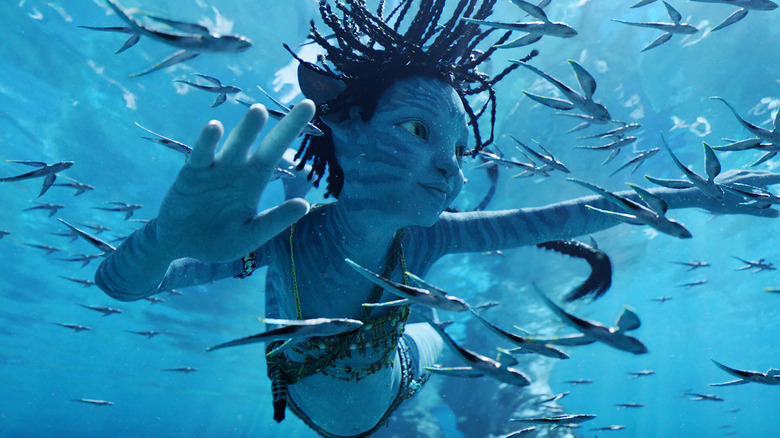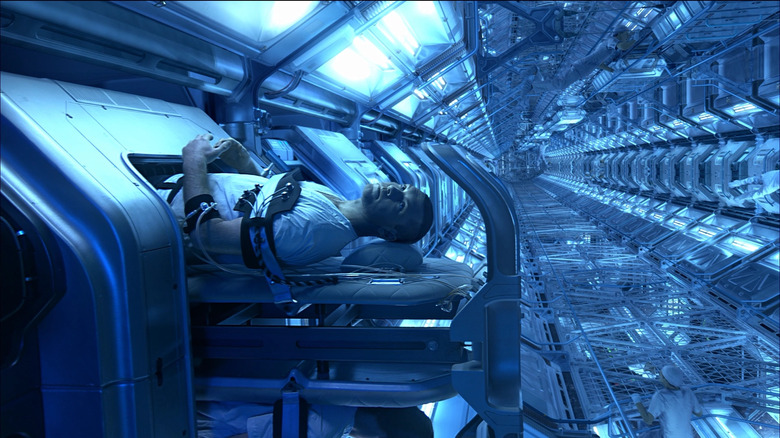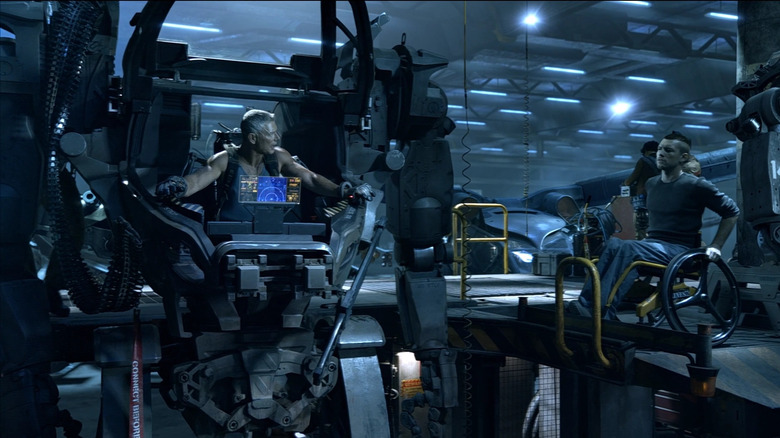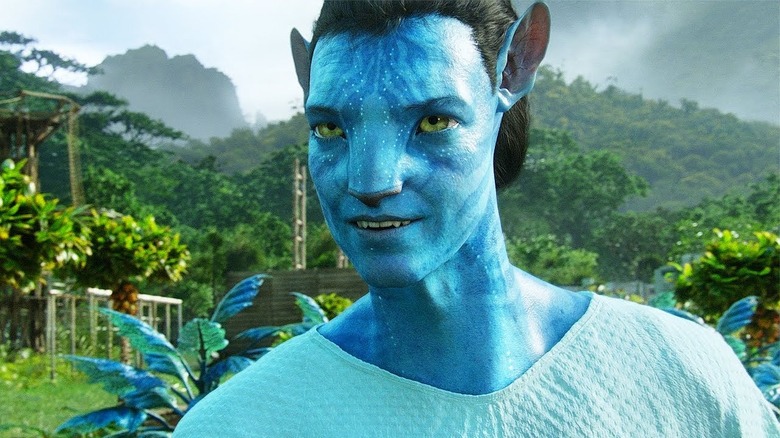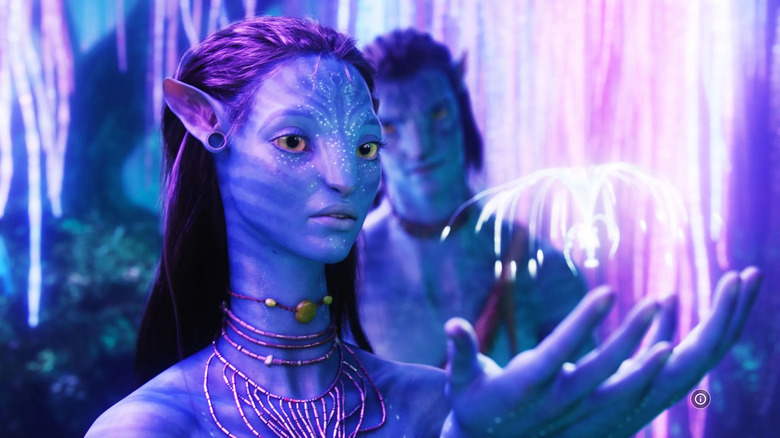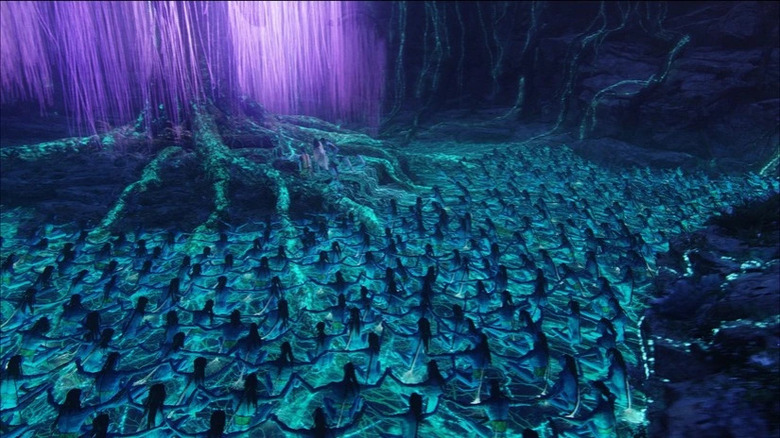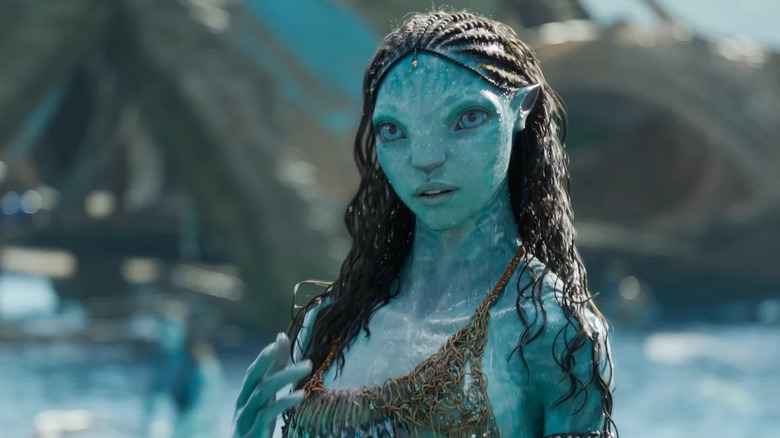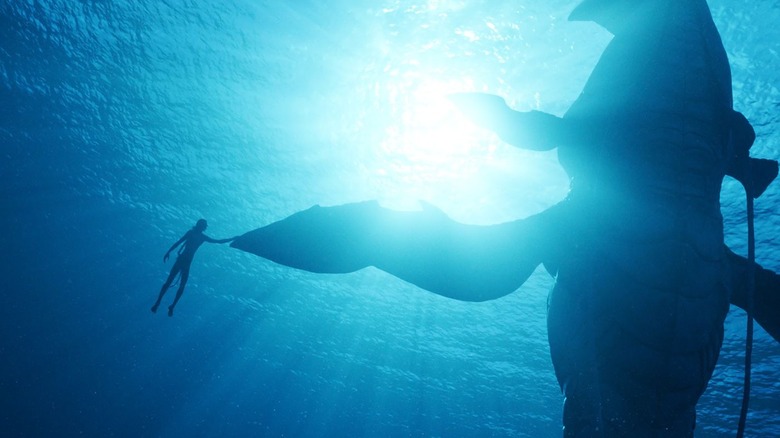5 Times The Avatar Franchise Got Its Science Right (And 5 Times It Didn't)
James Cameron has directed three of the four most successful movies of all time with "Titanic," "Avatar," and "Avatar: The Way of Water." But when he's not making billion-dollar blockbusters, he can be found at the bottom of the Mariana Trench gathering documentary footage, or innovating plant-based foods for "futurevores." Cameron's movies have fans all over the world, but the director himself is perhaps science's biggest fanboy, which is why — when it comes to his narrative work — he usually puts in some effort to make sure his science fiction is based on science fact.
For the world of "Avatar" in particular, he consulted with a variety of experts so that his story of an expedition to a distant moon in the year 2154 would ring true. Astronomy, physics, biology, botany, and geology, not to mention robotics and engineering, are everywhere in "Avatar" and "Avatar: The Way of Water." Science explains how the Resources Development Administration (RDA) grows avatars (via amnio tanks), how soldiers' face masks help them breath Pandora's air (which still contains oxygen, nitrogen, and carbon dioxide), and even how the Na'vi understand their god. However, shortcuts sometimes have to be taken or established theories tossed aside altogether for the sake of a better story. Here's what's good science and what's pure fantasy in James Cameron's "Avatar" franchise.
Moons like Pandora could support life
"Avatar" takes place on a fictional moon called Pandora that orbits a fictional gas giant planet known as Polyphemus. That moon looks suspiciously like our planet Earth, and despite some minor differences in atmosphere, it's able to sustain life. Believe it or not, the setting is one of the most plausible things about the "Avatar" films. In the popular imagination, space exploration's goal is to find alien lifeforms on habitable planets. But according to Space.com, such discoveries could be just as if not more likely to occur on moons like Pandora or, if you're a "Star Wars" fan, Endor.
For one thing, scientists believe there are many more moons than planets, not only in our own solar system (eight vs. 146, per NASA), but in the universe at large. Pandora is a Cameron creation, but the Alpha Centauri system in which it exists is real. One of its two stars, Alpha Centauri A, serves as Pandora's sun and is similar to our own. Most of the planets we've identified and named thus far are gas giants, like Jupiter, that are too close to their stars to support life.
Their moons, however, could be like our Jupiter's satellites: icy or rocky and closer to Earth's size, potentially with atmospheres. With cutting edge astronomical technology, we might be able to probe and analyze those moons someday to see whether they're home to water, oxygen, or carbon dioxide. Theoretically, a single gas giant in what NASA calls the Goldilocks zone could be orbited by multiple moons, each with its own unique landscapes, climates, and species.
Cryosleep and deep space travel aren't possible... yet
Even if Pandora could serve as an Earth 2.0, right now there'd be an insurmountable challenge in getting there. Cameron set the moon approximately 26 trillion miles away from us. For Jake Sully to get from Earth to Pandora, he has to be put in cryogenic hibernation and transported via spacecraft for a period of five years, nine months, and 22 days. In an interview with NPR, Popular Mechanics' Adam Hadhazy outlined why Jake wouldn't survive the trip. First, humans haven't yet invented vehicles that are capable of traveling at anywhere near the speed depicted in the film, which is about 70 percent the speed of light. While lightspeed travel could become a reality in the distant future, NASA is only in the very early stages of conducting such research.
The bigger problem is getting human bodies into deep space alive. Cryogenic freezing is an emerging science, at best. With enough money, according to Smithsonian magazine, anyone can preserve their body (or parts of it) this way, suspended in liquid nitrogen at a temperature of 320.8 degrees below Fahrenheit. But to date, no customer has ever been revived and no scientist knows how such a thing would even work. Jake's body is merely hooked up to a few sensors and tubes in the equivalent of a morgue compartment, and when he comes to, he's no worse for the wear. This plot point isn't completely disconnected from reality, but don't hold your breath for a near-lightspeed cryosleep ticket to Pandora anytime soon.
Exo-suits like the RDA's are being developed
Sci-fi action films are usually an opportunity for production designers to dream up whole fleets of futuristic-looking high tech vehicles, and one of the staples of the genre is the mech-suit. 2009's "Avatar" wasn't the first to feature a mech — they date back at least to 1967's "The Ambushers," which features an orange exo-suit — but it was among the first to make their design and method of operation reasonably believable. Lead designer TyRuben Ellingson told NPR that Cameron didn't want the RDA's military technology to seem too fantastical, so they imagined what current prototypes might look like in the near future. At the time, a company called Sarcos had developed a wearable robotic suit dubbed the XOS that could enhance lifting ability. Quaritch's AMP (amplified mobility platform) suit borrowed from the XOS.
In "Avatar: The Way of Water," the RDA mechs have become leaner and meaner, but these light mobility platforms or Skel Suits rely on the same basic principle to function. Cameron's mechs use mechanical telemetry translators in order for the suit to mimic the basic motions of the driver, as Ellingson explained to Gizmodo. In a case of life imitating art, a Korean company called Hankook Mirae Technology came up with a similar design named the Method-2 in 2016. Though it's entirely possible that mech-suits will be on the market in the coming years, innovating a remote power source remains an obstacle. The Method-2 was a plug-in model.
The Avatar program is far-fetched
Ironically, one of the least scientifically accurate things about the "Avatar" franchise is the premise itself. When his identical twin brother dies, Jake Sully gets drafted into the Avatar program to salvage the expensive Na'vi body that the RDA paid for. Jake and the other drivers are able to link up with their Avatars thanks to a combination of DNA mixing and data transferring; this allows their consciousness to enter a second body over which they have full control. Happily for the paraplegic Jake, this also means he's regained the use of legs again while in Na'vi form.
Unfortunately, according to Bangor University professor of cognitive neuroscience Guillaume Thierry, none of this is possible, nor is it likely to be anytime soon. As Thierry explained to Science Focus, "There's a popular idea that the brain is just like a computer, but it's not." The problem is two-fold. First, because the mind is, thus far, impossible to separate from the body, nobody really knows what human memories are made of, so scientists wouldn't know what to transfer or how to transfer it. Second, the human brain contains far too much data processing at far too fast a speed for even the world's most capable computer to contend with. Thierry points out that even a tiny sliver of a mouse's brain would take up two million gigabytes ... all of which means the Avatar program would be impractical even if it was possible. The same goes for Quaritch's personality download in "Avatar: The Way of Water."
Bioluminescence is a real phenomenon
The "Avatar" films are probably best known for their captivating, otherworldly environments. They're so beautiful and transporting, they even inspired their own theme park land at Walt Disney World's Animal Kingdom. But as it turns out, Pandora's flora and fauna aren't so otherworldly after all. Cameron worked with a botany consultant and plant physiologist — the University of California, Riverside's Professor Jodie Holt — to create living landscapes that could withstand scientific scrutiny. "The plants are fake, but the science is real," Holt told Phys.org.
Cameron gave Holt some geologic building blocks to work with. Pandora is a high-magnetism, low-gravity moon; these details led Holt to design oversized plants (like Hometree) that might grow in such a place. The most iconic thing about Pandora is its extreme bioluminescence. Not only might Pandoran plants and animals under the canopy evolve to display glowing colors, but bioluminescent life forms already exist here on Earth. One example: dinoflagellates, single-celled organisms that live in coral reefs. Visual effects supervisor Pavani Rao Boddapati told Nerdist that the neon creatures in "Avatar: The Way of Water" were inspired by dinoflagellates, which self-generate a bluish-green hue when disturbed. The sea life in the sequel behaves the same way; they light up when the Na'vi come into contact with them.
Floating mountains aren't compatible with life
Pandora's high-magnetism, low-gravity atmosphere is the rationale for its Hallelujah Mountains, too. These majestic floating chunks of verdant rock are loosely based on China's Zhangjiajie National Forest Park (per Atlas Obscura), but though Zhangjiajie's thousands of spindly peaks share Pandora's overall aesthetic, they're nevertheless firmly attached to the ground below.
According to scientists at Yale and Penn State, floating mountains could occur in isolation. One in-world explanation for the levitating monoliths in "Avatar" is that they contain unobtanium, which is so valuable to humans because it's a superconductor at room temperature. Because of two principles called the Meissner Effect and Lenz's Law, masses of terrain that were made up of enough unobtanium could repel other magnetic forces and stay suspended in mid-air. But with such low levels of gravity, there wouldn't be waterfalls in the Hallelujah mountains, nor would the Na'vi be able to walk around on them. In fact, there probably wouldn't be Na'vi at all: the radiation would destroy the cell tissue of any plant or animal life.
A quick side note about unobtanium: though some critics and audiences made fun of Cameron for choosing such an on-the-nose name for his MacGuffin, the term has been used by scientists as a sort-of in joke for decades (per Smithsonian magazine), long pre-dating the "Avatar" films. If Cameron wanted to be a stickler about it, he should have called his priceless space ore "unobtanite," since the "ite" suffix is used to classify minerals.
Plants can communicate via network
"Avatar" and "Avatar: The Way of Water" combine science fiction and fantasy, especially when it comes to the Na'vi and their beliefs. They worship Eywa, a mother-of-all-life figure, and view their energy (as well as the energy used by all plants and animals) as being merely borrowed from her life force. In both films, we witness Na'vi characters connect their neural whips or queues to trees that work almost like living servers, where they can access the memories and perhaps even the souls of their ancestors. That's pure fiction, but the basic idea of Dr. Grace Augustine's global network theory isn't that far-fetched.
Botany consultant Jodie Holt told Phys.org that Cameron originally intended the plants on Pandora to communicate through nerves. Since plants don't have nervous systems per se, Holt suggested he should change the official explanation to signal transduction. Signal transduction isn't entirely understood yet, but in short, it's a network-like system that plants use to send and respond to information for their own health and defense. For example, a plant's roots might tell its leaves how to behave or its flowers when to bloom, perhaps through small amounts of electricity or biochemical reactions. Cameron's version is a bit more metaphysical and spiritual, but at Holt's request, they wrote the phrase "signal transduction" into Sigourney Weaver's dialogue as a more scientifically accurate basis for the mythology.
Dr. Grace Augustine's methods are sloppy
Dr. Jodie Holt wasn't just a consultant on "Avatar"; she also helped to inform the character of Dr. Grace Augustine, the altruistic xenobiologist whose work with the Avatar program is funded by RDA, although she and the private paramilitary organization often butt heads. In an interview with ScienceLine, Holt said that production designers inquired about what she wore and what she brought with her into the field. They observed her handling plants, taking samples, and working in a laboratory setting, all in an effort to make Grace and her lab more authentic. Apparently, those designers didn't pay close enough attention.
Holt and her fellow botanists were confused by a few of Grace's actions once the film was released. For example, at one point, Grace stabs a syringe into a tree in an effort to collect some of its DNA. A real botanist would have carefully taken a small cutting from a leaf, which Holt admits wouldn't be as dramatic in the context of a movie. Botanists caught another slip up: Grace holds her pipette upside-down. It's also unrealistic that Grace would smoke. Though it's meant to be a character flaw that adds interest to the embattled Avatar program head, real scientists would refrain from this bad habit since tobacco would contaminate and compromise their lab results.
The Metkayina's evolutions make sense...
"Avatar: The Way of Water" takes audiences to Pandora's coral reefs, where we meet the Metkayina, a subspecies of Na'vi that have adapted to their tropical, largely aquatic habitat. Some of those adaptations are plain to see as soon as Jake Sully and family step upon their shores. These Na'vi are a paler shade of turquoise compared to the forest-dwelling Omatikaya, with thicker and flatter tails and fin-like wrists. Also, when Tsireya steps out of the water to greet their visitors, her eyes blink with a third eyelid.
The Metkayina have lived separately from the other Na'vi for at least thousands of years, according to Cameron's lore. That's a relatively short amount of time for such adaptations to have evolved, but it does make sense that given enough time, these humanoids would retain the mutations that make the best use of their surroundings.
Take those extra eyelids: Scientific American calls them nictitating membranes. Most animals have them, including fish, reptiles, amphibians, birds, and in some cases, mammals (cats are one example), though they're uncommon in primates. Cameron conceived of the Na'vi as having gills, but they were later redesigned to have cat-like features, so Reya's double blink doesn't come out of nowhere. The Metkayina's nictitating membrane could have evolved to protect the surface of their eyes from all those hours spent underwater, which is one of their purposes in the animal kingdom. Though people don't have them as a rule, doctors have documented cases of them in human beings (via the National Library of Medicine).
...But Na'vi biology doesn't
A great deal of painstaking research went into the creature designs of both "Avatar" and "Avatar: The Way of Water." In the behind-the-scenes documentary, "Capturing Avatar," Cameron details how he and his design team used real animals as inspiration, but made their fictional versions hexopedal as opposed to quadrapedal, meaning Pandoran wildlife gets around on six legs instead of four. They applied this same self-imposed biological standard to the animals in "Avatar: The Way of Water." The tulkun resemble whales, but with an extra set of fins and aspects of turtles and seals (per IndieWire). Pandora's animals might be make-believe, but they're at least consistent and their physiology and movement are grounded in reality.
We can't say the same about the Na'vi. While Earth is home to beings with four, six, eight, or more limbs, it's odd that the Na'vi are just about the only tetrapods on Pandora (if we don't count the wood sprites), especially since they share the same queues (those magic ponytails) that most other species have, too. They have some characteristics of placental mammals (bellybuttons, breasts), but they don't appear to have any body fat, which would be required for gestation and nursing. Biologist and anatomy consultant Stuart Sumida told Slate that their thin, 10-foot-tall frames don't offer any obvious advantages, nor do their big eyes or four fingers. The point of Na'vi bodies has to do more with exoticism and attractiveness than alien evolutionary biology.
